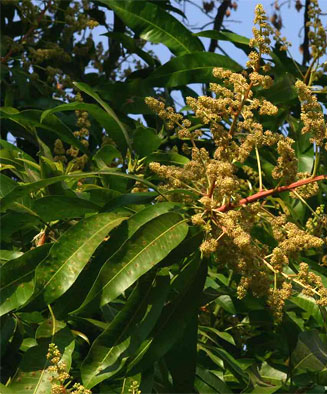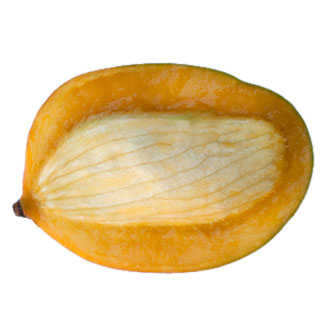|
Mangifera indica (Mango)
Life
> eukaryotes >
Archaeoplastida >
Chloroplastida
>
Charophyta > Streptophytina > Plantae (land plants)
> Tracheophyta (vascular plants) > Euphyllophyta > Lignophyta (woody plants)
> Spermatophyta (seed plants) > Angiospermae (flowering
plants)
> Eudicotyledons > Core Eudicots > Rosids > Eurosid II > Order: Sapindales > Family: Anacardiaceae
 |
 |
|
Mangifera indica, Victoria Falls, Zimbabwe. [photos
Bart Wursten ©, Flora of Zimbabwe] |
 |
 |
|
Mangifera indica, Val D'Or, Zimbabwe. [photos
Bart Wursten ©, Flora of Zimbabwe] |
Mangifera indica, Victoria Falls, Zimbabwe. [photos
Bart Wursten ©, Flora of Zimbabwe] |
 |
 |
|
Mango fruit. [photos
H.G.
Robertson, Iziko ©] |
The Mango is native to Burma and NE India and its
cultivation extends back to about 2000 BC.
The Mango Tree is native to Burma and NE India
and can grow to a height of over 40 m and live for more than a century. It is
thought to have been planted as a fruit tree in India as far back as 2000 BC.
Over time, plants have been selected that have larger, more flavourful fruit with
less resin and fiber, and smaller pits. However, this has been difficult because they are
cross-pollinated so that it is difficult to develop independent breeding lines.
The long generation time is an added problem to the selection process. One
way of getting round these problems has been to use vegetative propagation by
grafting.
Introduction of Mango trees to the rest of subtropical
Asia is thought to have started by about 400 BC. The Portuguese planted Mango
trees in coastal areas of East and West Africa in the 17th century but has been
suggested that they reached Africa earlier than this with Persian and Arab trade
to East Africa. They were first planted in South America (in Brazil) in
about 1700. Towards the end of the 19th century Mango trees had been introduced
to most parts of the World where they could grow.
The leaves and sap can cause skin
problems (dermatitis). Eating too much mango can evidently cause kidney
inflammation.
Ecological relationships
Herbivores in southern Africa
Endophytes
Acetobacter diazotrophicus
Bacteria
Acid-producing, nitrogen-fixing bacterium that is found in fruit of mango
plants. |
|
|
|
Links
Publications
-
Grové, T., Giliomee, J.H. & Pringle, K.L.
2001. Thrips (Thysanoptera) species associated with mango trees in South
Africa. African Entomology 9: 153-162.
-
Sauer, J.D. 1993. Historical geography of
crop plants - a select roster. CRC Press, Boca Raton, Florida.
Text by Hamish Robertson
|
